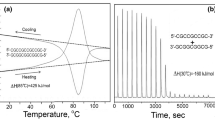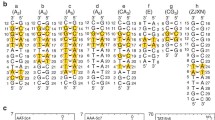Abstract
We show using polyacrylamide gel electrophoresis that guanine+adenine repeat strands of DNA associate into homoduplexes at neutral pH and moderate ionic strength. The homoduplexes melt in a cooperative way like the Watson-Crick duplex, although they contain no Watson-Crick base pair. Guanine is absolutely needed for the homoduplex formation and the homoduplex stability increases with the guanine content of the repeat. The present results have implications for the nature of the first replicators, as well as regarding forces stabilizing the duplexes of DNA.




Similar content being viewed by others
References
Casasnovas JM, Huertas D, Ortiz-Lombardía M, Kypr J, Azorín F (1993) Structural polymorphism of d(GA.TC)n DNA sequences: intramolecular and intermolecular associations of the individual strands. J Mol Biol 233:671–681
Dzantiev L, Alekseyev YO, Morales JC, Kool ET, Romano LJ (2001) Significance of nucleobase shape complementarity and hydrogen bonding in the formation and stability of the closed polymerase-DNA complex. Biochemistry 40:3215–3221
Finch JT, Klug A (1969) Two double helical forms of polyriboadenylic acid and the pH-dependent transition between them. J Mol Biol 46:597–598
Gellert BM, Lipsett MN, Davies DR (1962) Helix formation by guanylic acid. Proc Natl Acad Sci USA 48:2013–2019
Gilbert W (1986) The RNA world. Nature 319:618
Guckian KM, Morales JC, Kool ET (1998) Structure and base pairing properties of a replicable nonpolar isostere for deoxyadenosine. J Org Chem 63:9652–9656
Guschlbauer W, Chantot J-F, Thiele D (1990) Four-stranded nucleic acid structures 25 years later: from guanosine gels to telomer DNA. J Biomol Struct Dyn 8:491–511
Han H, Hurley LH, Salazar M (1999) A DNA polymerase stop assay for G-quadruplex interactive compounds. Nucleic Acids Res 27:537–542
Hardin CC, Perry AG, White K (2001) Thermodynamic and kinetic characterization of the dissociation and assembly of quadruplex nucleic acids. Biopolymers 56:147–194
Huertas D, Bellsolell L, Casasnovas JM, Coll M, Azorín F (1993) Alternating d(GA)n DNA sequences form antiparallel stranded homoduplexes stabilized by the formation of G.A base pairs. EMBO J 12:4029–4038
Joyce GF, Schwartz AW, Miller SL, Orgel LE (1987) The case for an ancestral genetic system involving simple analogues of the nucleotides. Proc Natl Acad Sci USA 84:4398–4402
Keniry MA (2001) Quadruplex structures in nucleic acids. Biopolymers 56:123–146
Kypr J, Vorlickova M (2001) Dimethylsulphoxide-stabilized conformer of guanine-adenine repeat strand of DNA. Biopolymers (Biospectroscopy) 62:81–84
Kypr J, Vorlickova M (2002) Circular dichroism spectroscopy reveals invariant conformation of guanine runs in DNA. Biopolymers (Biospectroscopy) 67:275–277
Larralde R, Robertson MP, Miller SL (1995) Rates of decomposition of ribose and other sugars: implications for chemical evolution. Proc Natl Acad Sci USA 92:8158–8160
Lee JS (1990) The stability of polypurine tetraplexes in the presence of mono- and divalent cations. Nucleic Acids Res 18:6057–6060
Lee JS, Evans DH, Morgan AR (1980) Polypurine DNAs and RNAs form secondary structures which may be tetra-stranded. Nucleic Acids Res 8:4305–4320
Levy M, Miller SL (1998) The stability of the RNA bases: implications for the origin of life. Biochemistry 95:7933–7938
Morales JC, Kool ET (1998) Efficient replication between non-hydrogen-bonded nucleoside shape analogs. Nat Struct Biol 5:950–954
Morales JC, Kool ET (2000) Functional hydrogen-bonding map of the minor groove binding tracks of six DNA polymerases. Biochemistry 39:12979–12988
Nielsen PE (1999) Peptide nucleic acid. A molecule with two identities. Acc Chem Res 32:624–630
Ohtsuki T, Kimoto M, Ishikawa M, Mitsui T, Hirao I, Yokoyama S (2001) Unnatural base pairs for specific transcription. Proc Natl Acad Sci USA 98:4922–4925
Orgel LE (1998) The origin of life: a review of facts and speculations. Trends Biochem Sci 23:491–495
Ralph RK, Connors WJ, Khorana HG (1962) Secondary structure and aggregation in deoxyguanosine oligonucleotides. J Am Chem Soc 84:2265–2266
Rich A, Davies DR, Crick FHC, Watson JD (1961) The molecular structure of polyadenylic acid. J Mol Biol 3:71–86
Rippe K, Fritsch V, Westhof E, Jovin TM (1992) Alternating d(G-A) sequences form a parallel-stranded DNA homoduplex. EMBO J 11:3777–3786
Shafer RH (1998) Stability and structure of model DNA triplexes and quadruplexes and their interactions with small ligands. Prog Nucleic Acid Res Mol Biol 59:55–94
Shapiro R (1995) The prebiotic role of adenine: a critical analysis. Origins Life Evol Biosphere 25:83–98
Shapiro R (1999) Prebiotic cytosine synthesis: a critical analysis and implications for the origin of life. Proc Natl Acad Sci USA 96:4396–4401
Sowerby SJ, Cohn CA, Heckl WM, Holm NG (2001) Differential adsorption of nucleic acid bases: relevance to the origin of life. Proc Natl Acad Sci USA 98:820–822
Tae EL, Wu Y, Xia G, Schultz PG, Romesberg FE (2001) Efforts toward expansion of the genetic alphabet: replication of DNA with three base pairs. J Am Chem Soc 123:7439–7440
Usdin K, Woodford KJ (1995) CGG repeats associated with DNA instability and chromosome fragility form structures that block DNA synthesis in vitro. Nucleic Acids Res 23:4202–4209
Vorlíčková M, Kejnovská I, Kovanda J, Kypr J (1999) Dimerization of the guanine-adenine repeat strands of DNA. Nucleic Acids Res 27:581–586
Watson JD, Crick FH (1953) Genetical implications of the structure of deoxyribonucleic acid. Nature 171:964–967
Wächtershäuser G (1988) An all-purine precursor of nucleic acids. Proc Natl Acad Sci USA 85:1134–1135
Weitzmann MN, Woodford KJ, Usdin K (1996) The development and use of a DNA polymerase arrest assay for the evaluation of parameters affecting intrastrand tetraplex formation. J Biol Chem 271:20958–20964
Weitzmann MN, Woodford KJ, Usdin K (1997) DNA secondary structures and the evolution of hypervariable tandem arrays. J Biol Chem 272:9517–9523
Woodford KJ, Howell RM, Usdin K (1994) A novel K+-dependent DNA synthesis arrest site in a commonly occurring sequence motif in eukaryotes. J Biol Chem 269:27029–27035
Wu Y, Ogawa AK, Berger M, McMinn DL, Schultz PG, Romesberg FE (2000) Efforts toward expansion of the genetic alphabet: optimization of interbase hydrophobic interactions. J Am Chem Soc 122:7621–7632
Acknowledgements
This work was supported by grants 301/01/0590 from the Grant Agency of the Czech Republic and A4004201 from the Grant Agency of the Academy of Sciences of the Czech Republic.
Author information
Authors and Affiliations
Corresponding author
Rights and permissions
About this article
Cite this article
Kypr, J., Kejnovská, I. & Vorlíčková, M. DNA homoduplexes containing no pyrimidine nucleotide. Eur Biophys J 32, 154–158 (2003). https://doi.org/10.1007/s00249-003-0287-x
Received:
Revised:
Accepted:
Published:
Issue Date:
DOI: https://doi.org/10.1007/s00249-003-0287-x




